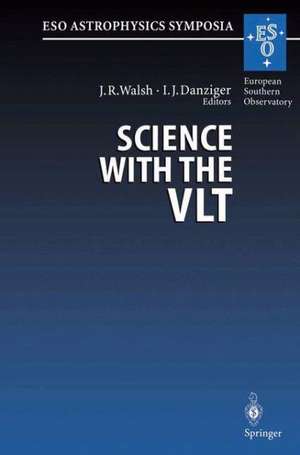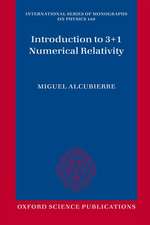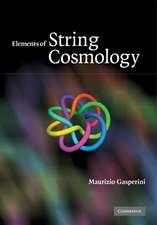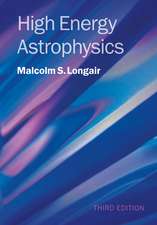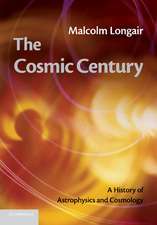Science with the VLT: Proceedings of the ESO Workshop Held at Garching, Germany, 28 June – 1 July 1994: ESO Astrophysics Symposia
Editat de Jeremy Walsh, Ivan J. Danzigeren Limba Engleză Paperback – 13 noi 2013
Din seria ESO Astrophysics Symposia
- 15%
 Preț: 656.43 lei
Preț: 656.43 lei - 15%
 Preț: 656.10 lei
Preț: 656.10 lei -
 Preț: 369.78 lei
Preț: 369.78 lei -
 Preț: 404.51 lei
Preț: 404.51 lei - 15%
 Preț: 644.95 lei
Preț: 644.95 lei - 15%
 Preț: 656.43 lei
Preț: 656.43 lei -
 Preț: 391.97 lei
Preț: 391.97 lei - 18%
 Preț: 971.01 lei
Preț: 971.01 lei -
 Preț: 434.94 lei
Preț: 434.94 lei - 15%
 Preț: 650.86 lei
Preț: 650.86 lei -
 Preț: 402.98 lei
Preț: 402.98 lei -
 Preț: 403.90 lei
Preț: 403.90 lei -
 Preț: 412.78 lei
Preț: 412.78 lei - 15%
 Preț: 645.47 lei
Preț: 645.47 lei -
 Preț: 431.30 lei
Preț: 431.30 lei - 15%
 Preț: 649.06 lei
Preț: 649.06 lei -
 Preț: 402.56 lei
Preț: 402.56 lei - 15%
 Preț: 647.27 lei
Preț: 647.27 lei -
 Preț: 413.15 lei
Preț: 413.15 lei -
 Preț: 409.30 lei
Preț: 409.30 lei -
 Preț: 430.10 lei
Preț: 430.10 lei -
 Preț: 406.42 lei
Preț: 406.42 lei - 15%
 Preț: 658.05 lei
Preț: 658.05 lei - 20%
 Preț: 590.38 lei
Preț: 590.38 lei -
 Preț: 400.65 lei
Preț: 400.65 lei -
 Preț: 413.15 lei
Preț: 413.15 lei - 15%
 Preț: 658.70 lei
Preț: 658.70 lei -
 Preț: 401.79 lei
Preț: 401.79 lei -
 Preț: 436.70 lei
Preț: 436.70 lei -
 Preț: 404.13 lei
Preț: 404.13 lei
Preț: 400.26 lei
Nou
Puncte Express: 600
Preț estimativ în valută:
76.60€ • 79.68$ • 63.24£
76.60€ • 79.68$ • 63.24£
Carte tipărită la comandă
Livrare economică 15-29 aprilie
Preluare comenzi: 021 569.72.76
Specificații
ISBN-13: 9783662223970
ISBN-10: 366222397X
Pagini: 508
Ilustrații: XXV, 477 p.
Dimensiuni: 155 x 235 x 27 mm
Greutate: 0.7 kg
Ediția:Softcover reprint of the original 1st ed. 1995
Editura: Springer Berlin, Heidelberg
Colecția Springer
Seria ESO Astrophysics Symposia
Locul publicării:Berlin, Heidelberg, Germany
ISBN-10: 366222397X
Pagini: 508
Ilustrații: XXV, 477 p.
Dimensiuni: 155 x 235 x 27 mm
Greutate: 0.7 kg
Ediția:Softcover reprint of the original 1st ed. 1995
Editura: Springer Berlin, Heidelberg
Colecția Springer
Seria ESO Astrophysics Symposia
Locul publicării:Berlin, Heidelberg, Germany
Public țintă
ResearchCuprins
1 The Solar System and Extra-Solar System Planets.- The Solar System and the VLT.- Very Distant Objects in the Solar System.- How to Search for Extra-Solar Planets with the VLT/VISA.- Astrometric Detection and Investigation of Planetary Systems with the VLT Interferometer.- 2 Star Formation.- Star Formation Studies with the VLT.- Circumstellar Disks with VLT/VLTI.- 3 Stellar Astrophysics.- Do We Need the VLT to Study Nearby Stellar Populations?.- Nucleosynthesis in the First Galactic Stars.- Elemental and Isotopic Abundances in Metal-Poor Stars.- Stellar Surface Structure: Doppler Imaging with the VLT-UVES.- Observation of Surface Activity on Cool Giants with the VLT Interferometer.- Imaging the Surfaces of Late-Type Stars.- A Sharper View on (Post-) AGB Evolution.- The Asymptotic Giant Branch in the LMC, SMC and the Galactic Center.- Prospects for Circumstellar Physics. Observations and Models.- Compact Stars In and Out of Binaries.- VLT High-Speed Spectro-Photometry: A Powerful Tool for Exploring Compact Stellar Objects and Related Phenomena.- Observational Astrophysics on Milli-, Micro-, and Nanosecond Timescales.- Problems and Prospects in White Dwarf Stars.- Mass Determination of Very Low Mass Stars.- Evolution of Massive Stars and the VLT.- 4 Stellar Clusters.- Globular Clusters with the VLT.- Detailed Analysis of Stars in the Galactic Bulge with the VLT.- Deep Star Counts and Cosmological Backgrounds: A Powerful New Model for the Point Source Sky.- 5 Interstellar Medium.- High Resolution Spectroscopy of the Interstellar Medium.- The Interstellar Medium in Galaxies.- 6 Astronomical Targets in Nearby Galaxies.- Supernovae and the VLT: More Light to Examine.- Supernovae with the VLT.- Late Stages of Supernovae with the VLT.- Faint Planetary Nebulae as Mass Tracers for Early Type Galaxies.- Resolving Distant Galaxies into Stars.- Proper Motions for the Nearest Galaxies Using ASTROCAM on the VLT.- Quantitative Spectroscopy of Luminous Blue Stars in Distant Galaxies.- Distance Indicators and the Expansion Field of the Universe.- Distance Indicators: Beyond Distances — A Return to Astrophysics.- 7 Active Galactic Nuclei.- High Resolution Infrared Imaging and Spectroscopy with the VLT: Galactic Nuclei.- Resolving Extragalactic Nuclei with the VLT.- Galaxy Dynamics, Black Holes and FUEGOS: Prospects for Studying Stellar Dynamics.- The VLT Contribution to Development of AGN Unified Schemes.- Subarcsecond Observations of Galactic Nuclei.- The AGN Environment.- 8 Quasars.- Quasar Surveys and the VLT.- QSO Absorption Line Systems.- 9 The Distant Universe.- Observational Cosmology with Faint Galaxies and a (9±1)-meter Telescope.- Deep Spectroscopy of 780 Galaxies: Results and Prospects for the VLT.- Deep Redshift Surveys on Faint Galaxies: Prospects for the VLT above z=1.- VLT Observations with Large Natural Gravitational Telescopes.- Integral Field Spectroscopy of Selected Extragalactic Objects with FUEGOS.- Perspectives in the Study of Large Scale Structure and Galaxy Evolution with the VLT.- The Nature of Compact Objects at R=23.- Faint AGNs, Evolution and the X-Ray Background.- 10 High-Resolution Imaging and Interferometry.- High-Resolution Imaging with the VLT at Optical Wavelengths.- From Planets to Galaxies: Adaptive Optics Revolution and VLT Interferometry.- A Strategy for High Angular Resolution Astrophysical Programmes at the VLT in the Visible.- Narrow-Angle Astrometry with the VLT Interferometer.- 11 Strategies for Use of the VLT.- Flexible Professional Observing at the VLT.- The VLT: max (4 × 8; 1 × 16; 1/X × 64)?.- 12Synopses of Panel Discussions.- I. Interferometry.- II. Future Instrumentation.
Recenzii
"...well-presented and thought-provoking, carefully dissecting individual goals and requirements for the future." - Irish Astronomical Journal
Textul de pe ultima copertă
ESO's new and exciting telescope, the VTL in Chile, will certainly bring a host of new results in optical astronomy for the years to come. This workshop surveys a large variety of possible observations and the needed instrumentation. It is an exciting overview of front research in astronomy rarely published before. The book covers the whole gamut of optical-IR astronomy from the Solar System, search for planets in nearby stars, physics of Galactic stars and clusters, Galactic structure, structure of nearby galaxies, AGN and quasars, clusters of galaxies, to large structure and cosmology. Furthermore it summarizes the two panel discussions.
